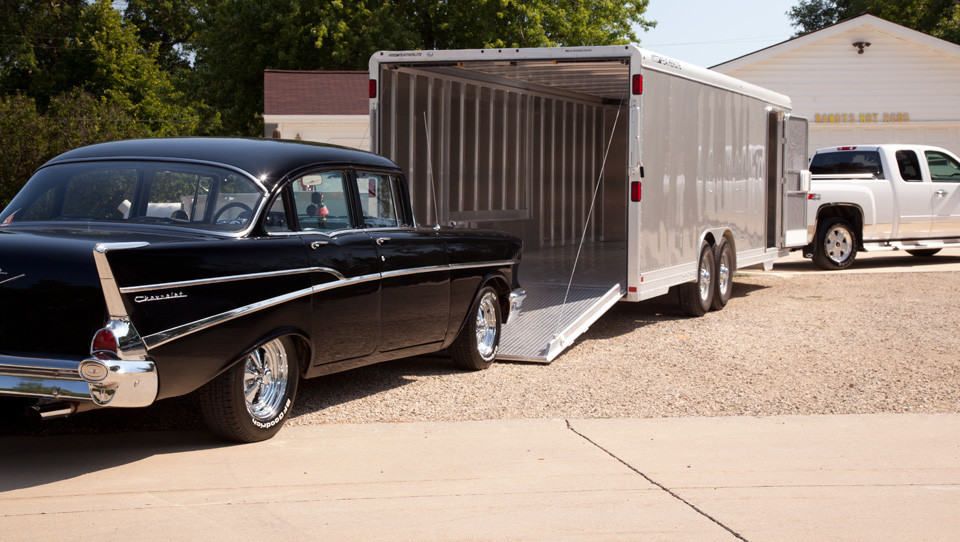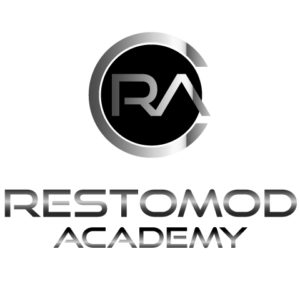I have driven myself crazy trying to find the perfect system for transporting and securing my restomod to car shows without it being a huge pain. Originally, I started by just driving my restomod to all car shows, which is my preference. I don’t like the idea of owning a “trailer queen” type of car.
However, I found driving to every show to be problematic. At some of the larger car shows, the parking lots were full. And, my car was getting hit by inadvertently opening their door into mine. Other times, especially in larger cities, I just found myself worrying about the vehicle’s safety. Would someone steal it? Would someone vandalize it?
Now, I’m really happy with my system for transporting my restomod. It basically consists of:
- An 8.5 x 22′ enclosed trailer with a ramp on the back. I love the enclosed trailer because it provides me with great peace of mind when traveling to and from car shows. In addition, don’t have to unload the car when I get home. The restomod just stays in there.
- This amazing vehicle tie-down kit (available on Amazon.com) that does a great job of securing the restomod.
One of the major factors to consider when buying any trailer, you should start deciding between an open and an enclosed trailer right away.
Enclosed Trailers

Enclosed car trailers can seem like the best option as they offer full-coverage from the elements and can be used for the permanent storage of the car. In addition, enclosed trailers also prevent any risk of damage to your car exterior from stones and other road debris. Generally, if people plan to travel across several states, they often prefer the enclosed option.
Open Trailers

Open car trailers are significantly less expensive, costing at least half of a quality enclosed trailer. The distance you plan to haul your car on the open road can help you make this decision. Stone guards, which block the main trailer deck from road debris, are an option if you buy an open trailer to transport your car.
Trailer Accessories, Additions, Upgrades
Your car trailer can come with the accessories that make it perfect for how you’ll use it.
Extra Height
If you know your car needs extra headroom, customize your enclosed trailer to feature a taller ceiling and door opening height. This can be a crucial upgrade for transporting tall classic cars such as a Model A.
Finished Interior
Sometimes the best car trailer doesn’t just perform the best, but it also looks the best, too. You can customize and finish the interior of your trailer to match your car’s paint job or your racing colors. Some restomod enthusiasts love going the extra mile and decorating their trailers, too.
AC Unit in Trailer
If you plan to spend some time in your enclosed trailer, a built-in AC unit goes a long way to make it more comfortable.
Open Center Car Trailer
This strategic opening also allows you to get underneath and do work on your car when it’s loaded on the trailer.
Observation Decks for Trailer Roof
A popular option for race teams, outfitting your trailer roof with an observation deck gives you a great seat to watch your restomod on the track.
Get-Out Door
An extra door that sits over the driver’s side wheel well, this upgrade allows you to open your car door through the get-out door and makes it easier to get out of your car while in the trailer — hence the name!
Related Classic Car Trailer Questions
The car hauler usually has larger channel for the frame which goes all the way to the rear of the trailer. Some utility trailers don’t have the main frame go all the way to the back of the trailer. Car haulers can’t have those side rails cause you wouldn’t be able to open the car’s doors.
An aluminum Featherlite 3110 Car Trailer[5] costs about $5,000-$6,000 new for the 14′ model and $7,200-$8,500 for the 22′ version. Enclosed car trailers sell for $6,000-$20,000 or more, depending on size, capacity, type of hitch (bumper pull or gooseneck) and materials.
A 16-foot trailer is an excellent compromise between accommodating most cars, and not being unwieldy to tow. Flatbed trailers are most commonly 16-20 feet long, and enclosed trailers are most apt to fall in the range of 20-24 feet. More important than length is the total load capacity.
GVWR stands for Gross Vehicle Weight Rating, and it’s a number that represents a maximum value of what your vehicle can safely weigh including payload. To give you an example, your truck may have an ’empty’ weight of 5,500 pounds (often called a “curb weight”) and a GVWR of 7,000 pounds.

